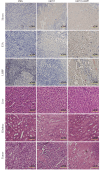Oncolytic adenovirus encoding LHPP exerts potent antitumor effect in lung cancer
- PMID: 38849383
- PMCID: PMC11161505
- DOI: 10.1038/s41598-024-63325-z
Oncolytic adenovirus encoding LHPP exerts potent antitumor effect in lung cancer
Abstract
LHPP has been shown to be a new tumor suppressor, and has a tendency to be under-expressed in a variety of cancers. Oncolytic virotheray is a promising therapeutics for lung cancer in recent decade years. Here we successfully constructed a new recombinant oncolytic adenovirus GD55-LHPP and investigated the effect of GD55-LHPP on the growth of lung cancer cells in vitro and in vivo. The results showed that LHPP had lower expression in either lung cancer cells or clinical lung cancer tissues compared with normal cells or tissues, and GD55-LHPP effectively mediated LHPP expression in lung cancer cells. GD55-LHPP could effectively inhibit the proliferation of lung cancer cell lines and rarely affected normal cell growth. Mechanically, the oncolytic adenovirus GD55-LHPP was able to induce stronger apoptosis of lung cancer cells compared with GD55 through the activation of caspase signal pathway. Notably, GD55-LHPP also activated autophagy-related signal pathway. Further, GD55-LHPP efficiently inhibited tumor growth in lung cancer xenograft in mice and prolonged animal survival rate compared with the control GD55 or PBS. In conclusion, the novel construct GD55-LHPP provides a valuable strategy for lung cancer-targeted therapy and develop the role of tumor suppress gene LHPP in lung cancer gene therapy.
© 2024. The Author(s).
Conflict of interest statement
The authors declare no competing interests.
Figures






Similar articles
-
A novel Golgi protein (GOLPH2)-regulated oncolytic adenovirus exhibits potent antitumor efficacy in hepatocellular carcinoma.Oncotarget. 2015 May 30;6(15):13564-78. doi: 10.18632/oncotarget.3769. Oncotarget. 2015. PMID: 25980438 Free PMC article.
-
Intratumoral delivery of a Tim-3 antibody-encoding oncolytic adenovirus engages an effective antitumor immune response in liver cancer.J Cancer Res Clin Oncol. 2023 Dec;149(20):18201-18213. doi: 10.1007/s00432-023-05501-8. Epub 2023 Dec 11. J Cancer Res Clin Oncol. 2023. PMID: 38078962
-
GP73-regulated oncolytic adenoviruses possess potent killing effect on human liver cancer stem-like cells.Oncotarget. 2016 May 17;7(20):29346-58. doi: 10.18632/oncotarget.8830. Oncotarget. 2016. PMID: 27121064 Free PMC article.
-
GOLPH2-regulated oncolytic adenovirus, GD55, exerts strong killing effect on human prostate cancer stem-like cells in vitro and in vivo.Acta Pharmacol Sin. 2018 Mar;39(3):405-414. doi: 10.1038/aps.2017.91. Epub 2017 Sep 7. Acta Pharmacol Sin. 2018. PMID: 28880012 Free PMC article.
-
A novel oncolytic adenovirus targeting Wnt signaling effectively inhibits cancer-stem like cell growth via metastasis, apoptosis and autophagy in HCC models.Biochem Biophys Res Commun. 2017 Sep 16;491(2):469-477. doi: 10.1016/j.bbrc.2017.07.041. Epub 2017 Jul 8. Biochem Biophys Res Commun. 2017. PMID: 28698142
References
MeSH terms
Grants and funding
- No. LGF21H160033/the Public Welfare Technology Project of Zhejiang Province
- No. 2021KY047/Zhejiang Medical Technology Plan Project
- No. 20201203B44/Hangzhou Science and Technology Bureau
- No. B20220173/Hangzhou Medical Health Science and Technology Project
- No. 20212BAG70043/the Applied Research and Cultivation Program of Jiangxi Province
LinkOut - more resources
Full Text Sources
Medical

